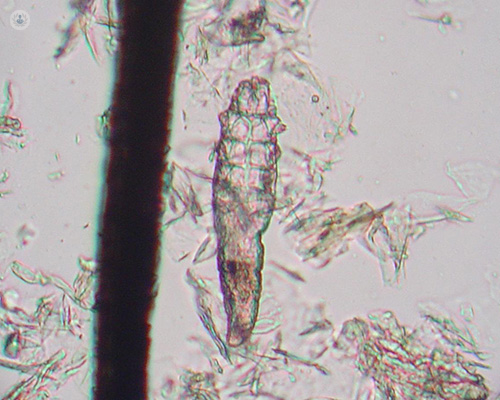Demodex
Mr Dilesh Makwana - Optometry
Created on: 01-08-2019
Updated on: 04-18-2023
Edited by: Jay Staniland
What is demodex?
Demodex folliculorum is a type of mite which is only able to survive on human skin. Demodex folliculorum is found on nearly all adults, and most people have the mite on their skin. The mites are usually harmless and are nothing to worry about, but they can sometimes cause skin problems, such as rosacea and blepharitis.
Another type of dermodex exists, called demodex brevis, which is found in the hair follicles and increases the number of skin cells within those follicles, making the skin look ‘scaly’.
What are the causes of demodex?
Both demodex folliculorum and demodex brevis mites can be found on most adults, growing in number as a person ages. They naturally occur on human skin, though they are not generally found on newborn babies, and are uncommon in children under ten. Certain people are more at risk from the mites and related skin conditions, including those who have a weakened immune system, HIV, existing acne, and alopecia.
What are the symptoms of demodex?
Symptoms of demodex folliculorum include:
- itchy skin
- redness, on the skin or in the eyes
- blushing or flushing in the face
- rough skin
- dry skin
These symptoms can often be confused with those of acne or particularly dry skin. Therefore, your doctor may take a skin biopsy to see if there is a large quantity of the mites on the skin.
Symptoms of demodex brevis can be similar, but in addition the skin may change in colour, appear scaly, or thicken in certain places, particularly the eyelid. Demodex brevis may also lead to loss of eyelashes.
How is demodex treated?
Most cases of demodex can be managed at home through trying to reduce the number of mites on the skin, including methods such as exfoliation, daily bathing, using mild shampoo, avoiding soap on the face, and other recommendations. Speak to your doctor or dermatologist for recommendations to reduce the number of demodex mites on the skin.
There are, however, medical treatments for demodex. In the case of demodex brevis, medication can be taken to regulate sebum production on the skin. In the case of demodex folliculorum, prescription facial care or topical skincare may be recommended, and in cases of demodex affecting the eyelashes, a special ointment may be prescribed.
Which specialist treats demodex?
Dermatologists typically diagnose and treat problems of the skin, but if the demodex affects your eyes, an ophthalmologist, optometrist, or orthoptist may be consulted.

